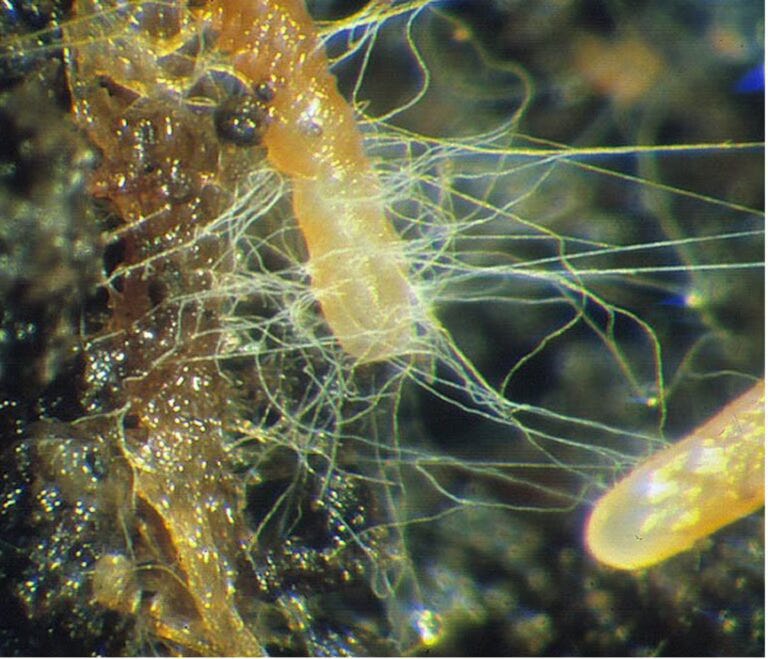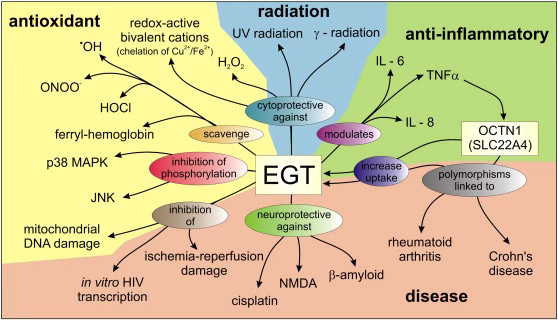How Fungi Connect Soil Health to Human Longevity
The soil microbiome functions as a sophisticated ecological interface where microbial metabolic pathways directly influence human nutritional outcomes through specialized molecular transfers. Ergothioneine (ERGO), a sulfur-containing amino acid with remarkable antioxidant stability and documented anti-inflammatory properties, exemplifies this soil-human connection through well-established biochemical pathways.
This compound moves through multiple biological systems via fungal-mediated transfer mechanisms, establishing direct nutritional connections between soil microbial communities and human health parameters. Research demonstrates that ERGO's movement through ecosystems follows consistent patterns influenced by agricultural management decisions, creating measurable relationships between farming practices and the availability of this potential "longevity vitamin" in the human diet.
ERGO's distinctive position in nutritional biochemistry stems from its biosynthetic exclusivity within soil microbial communities. Unlike common phytonutrients that plants can synthesize independently, ERGO production requires specific enzymatic pathways present only in select fungi and bacteria. This metabolic constraint establishes a direct trophic dependency between soil biodiversity and human nutritional status.
Quantitative analyses across agricultural systems demonstrate that microbial-mediated ERGO transfer efficiency varies by management intensity, with biologically active soils facilitating significantly higher ERGO translocation to crop tissues. This microbial-dependent pathway positions ERGO as a quantifiable biomarker linking soil ecosystem integrity directly to nutritional density in human food systems, revealing the ecological interdependence underlying human physiological resilience.
The Fungal Origins of a Longevity Molecule
ERGO's journey begins with soil microorganisms, particularly arbuscular mycorrhizal fungi (AMF). These remarkable fungi form symbiotic relationships with plant roots, creating vast underground networks that transfer nutrients. Research has demonstrated that AMF colonization significantly increases ERGO content in plant tissues, with studies showing dramatic results: black beans inoculated with one specific AMF strain (Septoglomus constrictum) demonstrated a remarkable 72-fold increase in ERGO content compared to controls. Similarly, asparagus treated with an AMF mixture showed a tenfold increase.
The relationship between soil fungi and ERGO levels in crops is clear and substantive. AMF colonization accounts for up to 89% of ERGO variation in crops and livestock products. This unseen exchange represents one of nature's most elegant nutritional pathways, developed over millions of years of co-evolution.
The Human Health Connection
Once ERGO enters the food chain, its journey leads ultimately to human consumption, where it performs vital functions. Unlike many dietary compounds, ERGO is highly bioavailable to humans and accumulates specifically in tissues subject to oxidative stress, such as erythrocytes. Its protective effects appear particularly important for neurological and cardiovascular health.
The evidence suggests that ERGO deficiency correlates strongly with conditions like Alzheimer's disease and cardiovascular problems, while also potentially affecting overall lifespan. Alarmingly, the average American consumes just 1.1 mg of ERGO daily—less than half the amount researchers consider protective for human health. More broadly, countries with lower estimated ERGO consumption have been associated with higher incidences of certain chronic neurological diseases and lower life expectancies.
Agriculture's Disruption of the ERGO Pipeline
Despite ERGO's importance, modern agricultural practices systematically disrupt the very networks responsible for its distribution. Conventional tillage practices can significantly reduce AMF populations by 30-60%, resulting in a 40-70% decrease in crop ERGO levels. Studies consistently show that ERGO concentrations in crops decline as tillage intensity increases, with approximately 30% reductions in corn, soybeans, and oats when comparing no-till methods to aggressive plowing practices.
Other common agricultural interventions further compromise this natural system. Synthetic nitrogen fertilizers diminish AMF colonization by 40-60%, while glyphosate herbicides reduce ERGO transfer efficiency by approximately 35%. Even crop selection matters—monocropping systems, particularly in wheat production, result in 50% lower AMF diversity compared to diversified crop rotations.
The consequences extend beyond plant foods directly into animal products. Research shows that grass-fed beef contains 59% more ERGO than grain-fed alternatives, with soil fungal biomass explaining 71% of this variation. This demonstrates how agricultural practices that damage soil health can cascade through the entire food system, ultimately affecting human nutrition.
Rebuilding Nature's Nutritional Highway
Fortunately, agricultural approaches that preserve and enhance soil fungal networks can restore this vital nutritional pathway. Regenerative agriculture practices offer promising solutions:
High quality compost applications can double AMF diversity
Cover cropping increases soil ERGO levels by approximately 30%
Polyculture systems potentially triple AMF activity
Reducing tillage preserves fungal populations and ERGO transfer efficiency
These interventions don't merely increase ERGO levels—they enhance overall soil health, crop resilience, and ecosystem function. By supporting the complex underground networks that have evolved over millions of years, regenerative agriculture practices reconnect the broken pipeline between soil microbes and human health.
A New Understanding of Public Health
This is a clear example of how public health begins in the soil. The nutritional quality of our food—and potentially our resistance to chronic diseases—depends on maintaining complex biological partnerships that modern agricultural systems have often disrupted.
This understanding suggests that addressing many modern health challenges may depend less on medical interventions than on rebuilding essential ecological relationships. By reconnecting the nutritional pipeline that flows from soil fungi to human health, we may discover that the path to longevity runs directly through the soil beneath our feet.
Key References on Ergothioneine and Soil Fungi
Ames, B. N. (2018). Prolonging healthy aging: Longevity vitamins and proteins. Proceedings of the National Academy of Sciences (PNAS).
Beelman, R. B., Kalaras, M. D., & Richie, J. P. (2020). Is ergothioneine a 'longevity vitamin' limited in the American diet? Journal of Nutritional Science.
Carrara, J. E., Lehotay, S. J., Lightfield, A. R., Sun, D., Richie Jr., J. P., Smith, A. H., & Heller, W. (2023). Linking soil health to human health: Arbuscular mycorrhizae play a key role in plant uptake of the antioxidant ergothioneine from soils. Plants, People, Planet, 5:449-458.
Heller, W. P., et al. (2021). Soil Disturbance Impact on Crop Ergothioneine Content Connects Soil and Human Health. Agronomy, 11(11), 2278.
Carrara, J.E., Heller, W.P., White, C.M., Culman, S.W., Smith, A.H. (2023). Inoculation of black turtle beans (Phaseolus vulgaris) with arbuscular mycorrhizal fungi to improve nutrient content, nutrient uptake, and yield of seeds. Plant, People, Planet.
USDA ARS. Sustainable Biofuels and Co-products Research - Project on soil health, ergothioneine, and human health connections.
Nakatani, T. (2020). Breakthrough in bio-based production of longevity vitamin ergothioneine. Nature.




I find your work fascinating. Thank you
Our farm began the process to convert to no-till in 1985. We converted some cropland to pasture, hay and trees. It took a number of years to increase and refine the no-till acres, so we are now almost 100% no-till. We began to add cover crops about 15 years ago and use cover crops on 50% of the land. It is an expensive! Our crops look much healthier now, partially because of increased soil organic matter and a large increase in earthworms. In looking at our crops, my intuition from 50 years of experience told me there was something else at work in the soil, increasing plant health. I suspected it was the soil microbiome and learned about AMF. Although I have no concrete evidence, in looking at the soil and from what I have studied, I am convinced that an active soil biome is at work. Tillage destroys that biome. Hydroponics does not allow for it. Nowhere in nature is the soil tilled. Soil, plants, fungi and bacteria developed a symbiotic relationship over millennia. I just discovered your site. Thanks for your insights.